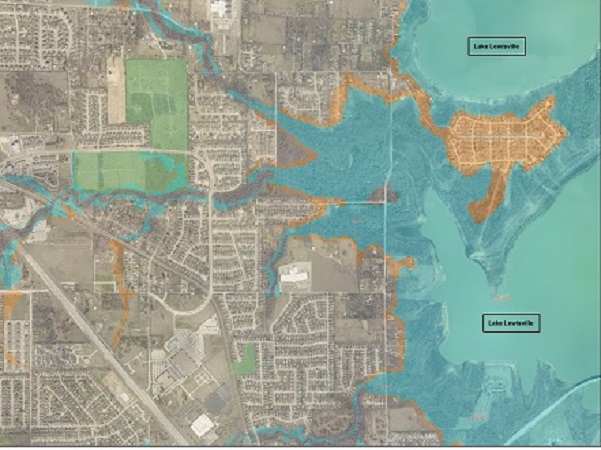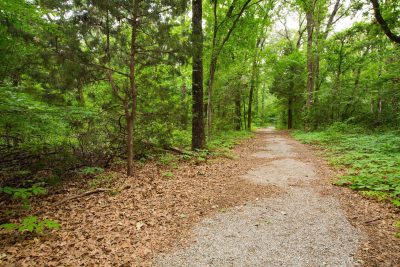Apply now to join our next cohort of Community Science Fellows and Community Leads!

Project Title: Balancing Sustainability Priorities with Development in an Urbanizing Watershed
Location: Corinth, Texas
The Team:
Corinth, Texas is located within the rapidly urbanizing Denton County, and is a suburb of the Dallas-Fort Worth Metroplex. This location and a large share of open land makes the city attractive to developers. Anticipating requests to build in portions of the floodplain or alter the flood plain, the city wanted to prepare guidelines for development in and around Lynchburg Creek. By aggregating the best and appropriate data and standards, the community hoped to develop implementable control strategies to mitigate stormwater runoff; protect water quality and preserve important landscape features and functions.
This project originated via connection of the community to Thriving Earth Exchange by Bob Hart, City Manager for Corinth, Texas. Bob formerly worked with Kennendale, Texas, another Thriving Earth Exchange alumni community.
The City of Corinth project team utilized green infrastructure techniques as their methodology to help manage stormwater runoff along Lynchburg Creek and throughout the City.
The team’s Thriving Earth Exchange partner and scientist, Fouad Jaber, provided technical advice and assistance regarding green infrastructure techniques and case study data to the community.
Data sources for fact sheets produced through the project also included the following: A&M Agrilife Extension Services, Environmental Protection Agency (EPA), Natural Resources Conservation Service, Texas Land Trust Council, Texas Agricultural Land And Trust, West Virginia Division of Forestry, and Texas A&M Soil, Water and Forage Lab. Data for the design standards and maintenance for each of the green infrastructure techniques was obtained by using the North Central Texas Council of Governments (NCTCOG) iSWM Manual as a resource.
Images and photos used for the project were from public online resources, as well as City staff. Introductory fact sheets were also created by City staff.
Information and graphics were created by City staff and input into the interactive story map using ESRI, as well as aerial images and City maps.
The project team met at least once a month at City offices with a monthly conference check-in call with Thriving Earth Exchange staff for the first several months due to staff changes at the city level. Once the permanent project team was in place, we met a minimum of once a month and twice a month, as schedules allowed with a monthly conference check-in call with our Thriving Earth Exchange project manager. The team achieved completion of the project within approximately 21 months.
The project team created an innovative, interactive web-based Green Infrastructure Plan utilizing the ESRI Story Map software. Available here: www.cityofcorinth.com/greeninfrastructure
The Green Infrastructure Plan tells Corinth’s story of our Thriving Earth Exchange partnership project identifying the purpose of our project – the management of stormwater runoff; particularly, into and along Lynchburg Creek.
The plan identifies our strategies for controlling stormwater runoff using Green Infrastructure techniques.
The interactive map of Lynchburg Creek identifies the appropriate green infrastructure techniques within three zones or locations with respect to the distances from the creek channel to be protected.
Each of the green infrastructure techniques contains links showing graphic depictions of those techniques along with descriptions, application of those techniques, fact sheets about those techniques, and minimum design standards and maintenance for each of those techniques.
The plan also includes an aerial site plan of a residential site randomly selected as a residential case study showing how green infrastructure techniques, such as permeable pavement walkways and driveways, rainwater harvesting, and rain gardens may be applied on that site along with the associated estimated cost to construct each of those techniques and calculations showing the estimated reduction of runoff for each of those techniques.
Another aerial site plan showing our City hall site as a non-residential case study is included showing the location and installation of potential future improvements, such as rain gardens, permeable pavement and rainwater harvesting on the site.
Additionally, the City hall site plan includes the estimated cost of installation for each of the green infrastructure techniques to mitigate stormwater and the estimated removal of pollutants from stormwater runoff, as well as the reduction of overall on-site stormwater runoff that can be realized on-site for City hall.
This is the City of Corinth’s first interactive, educational outreach program. It was presented to City Council and launched on August 22, 2019. The Green Infrastructure Plan was also presented to our partners with the Upper Trinity Regional Water District (UTRWD) and successfully helped to secure full support of our local conservation easement efforts. Additionally, this project will serve as one of the first projects to be featured on our Bang the Table EngagementHQ platform web-page, along with the update of our Comprehensive Plan and Master Parks and Trails Plan in which Lynchburg Creek will be addressed.
In addition to garnering support from our local leaders and partners, using this visual, interactive plan should go a long way in engaging our residents and promoting our plans for managing stormwater runoff using green infrastructure techniques city-wide and; particularly, in and along Lynchburg Creek.
This educational, marketing tool was the best available medium for our interactive, Green Infrastructure Plan and to tell our story. This resource has numerous applications across multiple departments that we will continue to employ in the future.
Other communities, public sector services and private industries could also benefit from use of this highly adaptable technology. Municipalities and other public sector services could use this technological resource in order to better engage their residents and reach a wider audience; thereby, enhancing transparency and gaining more credibility, trust and collaboration resulting in greater consensus of plans and projects.
Private sector industries could also benefit by using this platform as a great marketing tool to better tell their story, showcase their products and services, engage and reach more customers and expand into larger markets. This application can be utilized in multiple settings and across multiple industries.
Things that contributed to our success:
Things we might do differently if you were to do it over again.
Advice for people pursuing similar community science projects:


(Images of Lynchburg Creek courtesy of the City of Corinth, Texas)
Corinth, Texas is a city within rapidly urbanizing Denton County and a suburb of the Dallas-Fort Worth Metroplex. As an eight-square mile lake city, the local community is keenly aware of the importance of sound watershed management. Interstate 35 East bisects the City, with Lake Lewisville, a major source of drinking water, directly to its east. Recent development on the northeast side of I-35 East has contributed to increased stormwater runoff through Lynchburg Creek, a major tributary to Lake Lewisville. Lynchburg Creek is located within the Pecan Creek Lewisville Watershed.
The City of Corinth recognizes that development in Denton County is inevitable—an Oxford Economics Forecast estimates that the county will continue to lead as the top county in Texas for economic growth from 2017 through 2021. The proximity within the Metroplex and availability of vacant land on either side of I-35E makes the area an attractive place for developers. The City of Corinth anticipates requests from developers to fill-in a portion of the floodplain or alter the floodplain to create a deeper channel.
As a community, the City is interested to see development move forward in a sustainable manner to protect drinking water and mitigate for increased stormwater. In the recent past, Corinth has worked with consultants and engineers to examine drainage patterns through hydrologic modeling and risk mapping. A jointly funded study between the North Central Texas Council of Governments, Shady Shores, City of Corinth and FEMA is nearing completion and will provide a watershed-wide analysis on flooding and possible mitigation strategies. City staff are now interested to move beyond this phase to aggregate existing data and acquire new data to prepare guidelines for development in and around Lynchburg Creek. This work will direct the implementation of appropriate control strategies to mitigate stormwater runoff; protect water quality and preserve important landscape features and functions.
Community Leads

Lori Levy joined the City of Corinth as Senior Planner for the Planning and Development Department in 2015. Lori has over 15 years of professional planning experience, and has held progressively responsible positions in planning within the Dallas/Ft. Worth Metroplex. Prior to joining the City of Corinth, Lori was Planning Manager for the City of Carrollton and responsible for overseeing the day-to-day operations of Planning, as well as the departmental recommendations for zoning and development related cases.
Prior to the City of Carrollton, as Senior Planner with the City of Irving, Lori supervised the Current Planning staff, and worked on various complex development projects, including mixed-use projects. Lori began her planning career with the City of Fort Worth as an intern. She holds a Master’s degree in City and Regional Planning from the University of Texas at Arlington, and a Bachelor of Arts degree in History with a minor in Political Science from the University of New Orleans. She is AICP certified and a member of the American Planning Association and a member of the Congress of New Urbanism.
Scientific Partner

Dr. Fouad Jaber is an associate professor and integrated water resources management extension specialist at Texas A&M University located at the Dallas AgriLife Research and Extension Center. Dr. Jaber received his Ph.D. in Agricultural and Biological Engineering from Purdue University in December 2001 with emphasis in Natural and Environmental Resources Engineering. Dr. Jaber holds an M.S. degree in Irrigation, a B.S. in agriculture, and a diploma of “Ingenieur Agricole” from the American University of Beirut. He was also a post-doctoral research associate at the Agricultural and Biological Engineering Department of the University of Florida from 2002 to 2007, and was based at the Southwest Florida Research and Education Center in Immokalee, FL.
He has been conducting research and extension programs related to stormwater management, stream restoration, non-point source pollution management from the urban environment and water quality studies since 2002. He has published more than 100 refereed papers, extension publications, conference proceedings and governmental reports. Dr. Jaber is a registered Professional Engineer in the State of Texas.
(c) 2024 Thriving Earth Exchange